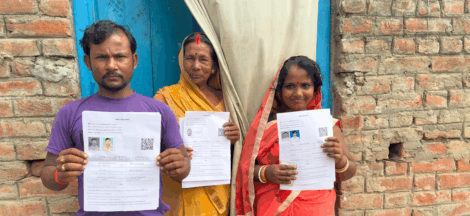By Dr. Gyan Pathak
The progress towards achieving SDG 8 targets aiming at full and productive employment and decent work for all by 2030 is threatened by numerous roadblocks. Though global unemployment hit a historic low of 5 per cent, women and youth face higher unemployment rates. Informal employment poses significant global challenge with over 2 billion workers in informal jobs lacking social protection in 2023. In the Least Developed Countries (LDCs), and in sub-Saharan Africa and Central and Southern Asia, nearly 9 in 10 workers are informally employed. Alarmingly, over one in five young people are not in education, employment or training (NEET). Compliance with fundamental labour rights has deteriorated.
This is the finding of the “2024 Sustainable Development Goals Report” by the United Nations that comes ahead of the High-Level Political Forum on Sustainable Development (HLPF) taking place at the UN Headquarters in New York from July 8 to July 17. Though the forum will not review the SDG 8 directly, it would review the SDG 1 on ending poverty, SDG 2 on zero hunger, SDG 13 on climate action, SDG 16 on peaceful and inclusive societies, and SDG 17 on means of implementation that is likely to impact the fate of SDG 8 also. In addition, the upcoming Summit of the Future in September will be pivotal for realigning efforts towards achieving the goals, since it would address the debt crisis affecting many developing countries and the urgent need to reform international financial architecture having great bearing on SDG 8: Decent Work and Economic Growth.
The 2024 report has said that progress towards SDG 8 faces headwinds from the COVID-19 aftermath, trade tensions, rising debt in developing countries, conflicts and geopolitical strains – collectively threatening global economic growth. While global real GDP per capita growth rebounded in 2021, it slowed in2022 and is projected to stabilize through 2025.
In 2023, the global NEET (Not in Education, Employment, and Training) rate among young people was 21.7 per cent, which was a notable decrease from 23.8 per cent in 2020.It closely matched the 2015baseline of 21.8 per cent and is expected to persist through 2025.
Northern Africa and Western Asia and Central and Southern Asia reported higher rates of 28.5 per cent and 27.4 per cent, respectively. Central and Southern Asia saw significant improvement, reducing its rate by 7.5 percentage points since 2005. Sub-Saharan Africa experienced an increase. Globally, young women are over twice as likely as young men to be NEET.
In Central and Southern Asia, nearly half of young women are NEET compared to only12.3 per cent of young men. Northern Africa and Western Asia echo this disparity. With about 269 million young people globally not in education or work in 2023, intensified efforts are needed to reduce NEET rates, particularly among young women, the report emphasized.
Fewer countries had an operationalized national strategy for youth employment in 2023 compared to previous years. Only 36 of 87 reporting countries had implemented such a strategy. Around one third had a strategy but without evidence of implementation. One fifth were developing one.
In 2023, the global unemployment rate fell to a record low of 5.0 per cent since 2000. The rate is projected to further drop to 4.9 per cent in 2024 and to stay the same level in 2025. Eastern and South-Eastern Asia, the LDCs and Landlocked Developing Countries (LLDCs) saw unemployment rates rise from 2019 to 2023. Northern Africa and Western Asia had the highest unemployment rate at 9.5 per cent, despite declines since the pandemic.
Women and youth continued to face higher unemployment rates globally and across regions. In 2023, gender unemployment gaps were similar to those in 2015, with the largest disparities in Northern Africa and Western Asia. Central and Southern Asia has made strides in narrowing the gap due to improved labour market access for women, particularly in Southern Asia.
Youth unemployment was over three times higher than adult rates globally, at 13.0 per cent compared to 3.7 per cent, respectively. While headline unemployment figures improved, persistent challenges such as working poverty and informal employment highlight ongoing struggles in realizing decent work.
From 2015 to 2022, the global average level of national compliance with labour rights declined by 7 per cent, with the average score worsening from 4.50 to 4.81. This indicator, ranging from 0 to 10, signifies national compliance with freedom of association and collective bargaining rights, with0 indicating the highest compliance and 10 the lowest.
The deterioration has affected developed, developing and least developed countries, with decreases of 0.2, 0.3 and 0.8 points, respectively, since 2020. Scores have worsened for 33 per cent of International Labour Organization (ILO) member States since 2020; only 11 per cent have improved their scores, partly due to legislative reforms.
Regional averages reflect substantial declines in Eastern and South-Eastern Asia, Central and Southern Asia, Europe and Northern America and Latin America. Northern Africa and Western Asia saw marginal improvements. Increased violations and restrictions on civil liberties, especially in union formation and bargaining rights, drive the trend. Freedom of association and collective bargaining are enabling rights to exercise fundamental rights at work, with a crucial role in social justice.
Globally, over 2 billion people were in informal employment in 2023, comprising 58.0 per cent of the global workforce, a share projected to slightly decrease to 57.8 per cent in 2024. This rate is down from 58.4per cent in 2015, reaching its lowest point, but the number of informal workers is at its highest level. This suggests that widespread formalization is unlikely soon.
Economic challenges are pushing workers into informal jobs without social protection, a significant barrier to social justice. Informal employment persisted most notably in the LDCs at 89.1 per cent in 2023, a rate nearly unchanged since 2015. The rate in Europe and Northern America was only 11.4 per cent. Women, particularly in the LDCs and regions with high informality rates, experienced a disproportionate increase in informal employment during the pandemic. Over 90 per cent of employed women in the LDCs and nearly 90 per cent in sub-Saharan Africa and Central and Southern Asia performed informal work. (IPA Service)



